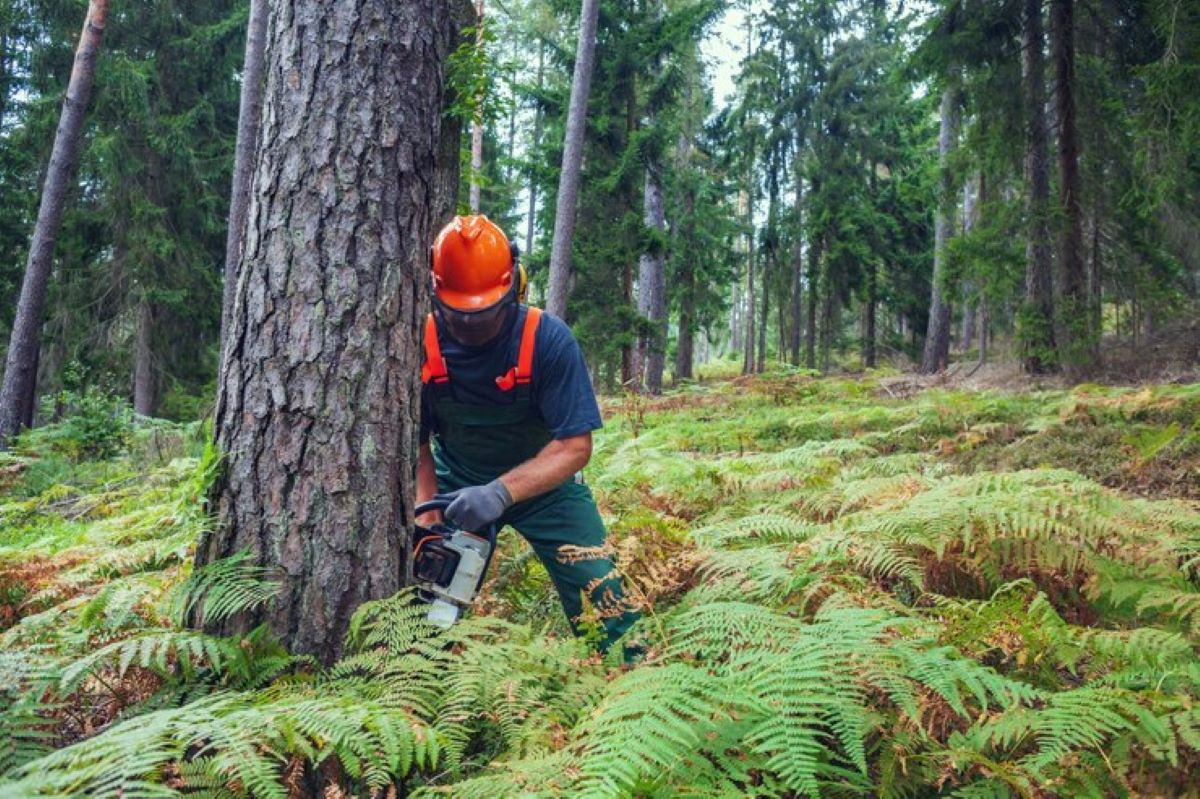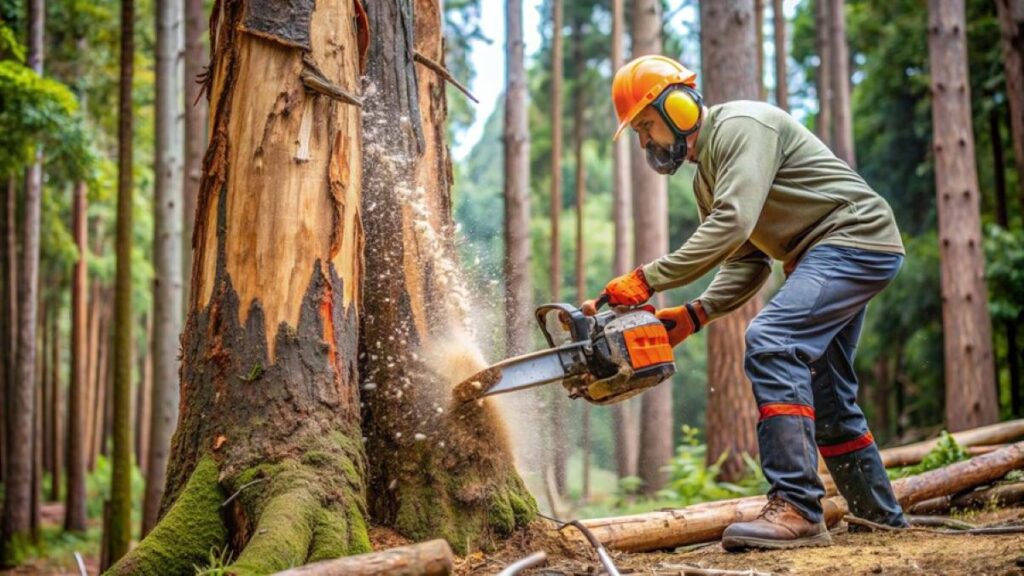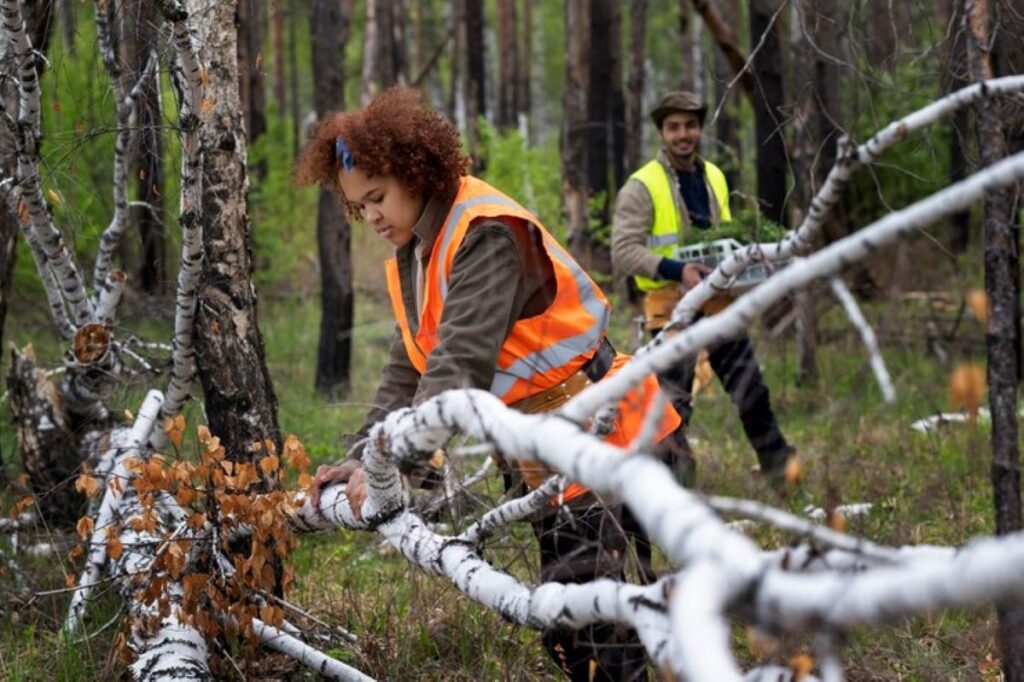
Trees are like silent protectors of properties in North Sydney. They offer shade, beauty, and environmental benefits that can greatly increase the value of a property. However, these natural assets cannot warn owners when diseases, structural damage, or pest infestations threaten their well-being and safety.
Professional tree services in North Sydney help safeguard your investment by spotting issues before they turn into expensive emergencies. Skilled arborists possess specialised knowledge to identify problems that may be invisible to untrained individuals, such as internal decay or failures in the root system.
It’s important to have an understanding of common tree problems that require arborist expertise:
- Unusual leaf discolouration or premature dropping
- Structural cracks compromising stability
- Dead branches posing fall risks
- Fungal growth indicating internal rot
- Exposed roots weakening anchorage
- Termite infestations hollowing trunks
Being able to identify the top 5 signs you need professional tree services North Sydney will help ensure that your trees remain healthy assets instead of becoming hazardous liabilities. By seeking early intervention from trained specialists, you can preserve tree health, protect both people and property, and comply with local regulations regarding tree care and removal.
What Are the Top Signs That Indicate You Need Professional Tree Services in North Sydney?
Recognising signs needing tree services early can prevent property damage, injuries, and costly emergency interventions. North Sydney property owners should watch for five critical tree health indicators that signal the need for expert assessment.
- Unusual leaf behaviour: Discoloured, wilting, or prematurely dropping leaves often indicate disease, pest infestation, or environmental stress that requires professional diagnosis.
- Structural damage: Cracks or splits in the trunk compromise tree stability. These defects can lead to sudden collapse, particularly during storms or high winds.
- Dead or hanging branches: These create immediate hazards for people, vehicles, and structures below. Professional arborists safely remove these risks before accidents occur.
- Fungal growth: At the tree base reveals internal decay that weakens the entire structure. Mushrooms or conks sprouting from roots or trunks demand urgent professional attention.
- Root system damage: From construction, erosion, or disease affects the tree’s ability to anchor itself and absorb nutrients. Exposed or severed roots require expert evaluation to determine if the tree remains viable.
Knowing when to call arborist services makes the difference between simple treatment and complete tree removal. Early detection allows professionals to implement targeted solutions—pruning diseased limbs, treating pest infestations, or stabilising compromised structures—that preserve tree health and extend lifespan whilst protecting your property investment.
Why Is Unusual Leaf Behaviour a Signal to Contact Tree Professionals?
Leaf discoloration and premature leaf drop serve as early warning systems that something is compromising your tree’s internal processes. Healthy trees maintain vibrant foliage throughout the growing season, so yellowing leaves in spring or summer, brown patches spreading across the canopy, or leaves falling months before autumn indicate stress from disease, pest infestation, or environmental factors.
These tree health symptoms often point to issues invisible to untrained eyes. Nutrient deficiencies may cause yellowing between leaf veins, whilst fungal infections create distinctive spotting patterns. Root damage restricts water uptake, leading to wilting and browning despite adequate rainfall.
Qualified arborists possess the diagnostic expertise to identify the underlying cause rather than treating surface symptoms. They examine leaf patterns, conduct soil tests, and assess the entire tree system to determine whether the problem stems from:
- Bacterial or fungal pathogens requiring targeted treatment
- Pest activity damaging leaf tissue
- Soil compaction or drainage issues affecting root function
- Chemical exposure from nearby construction or improper fertilisation
Early professional intervention prevents minor issues from escalating into irreversible decline that could necessitate complete tree removal.
How Do Cracks or Splits in the Trunk Affect Tree Safety and Health?
Trunk cracks compromise structural integrity and create immediate hazards. Vertical splits or deep fissures weaken the tree’s ability to support its weight, making collapse a real possibility during storms or high winds.
Hazardous trees with visible trunk damage pose serious threats to nearby structures, vehicles, and people. A compromised trunk cannot distribute stress properly, leading to sudden failure without warning. The risk intensifies as cracks deepen or widen over time, particularly in mature trees with heavy canopies.
Professional arborists assess crack severity using specialized tools and techniques:
- Resistograph testing measures internal decay beneath visible cracks
- Visual inspection determines crack depth, location, and growth patterns
- Load assessment evaluates the tree’s ability to withstand environmental stresses
- Cabling or bracing systems provide structural support for salvageable trees
Qualified tree professionals in North Sydney determine whether damaged trees require reinforcement, selective pruning to reduce weight, or complete removal. This expert evaluation prevents catastrophic failures that could result in property damage or personal injury, making trunk cracks one of the Top 5 Signs You Need Professional Tree Services in North Sydney.
When Do Dead or Falling Branches Warrant Professional Attention?
Dead branches become urgent safety concerns when they hang over walkways, driveways, buildings, or areas where people gather regularly. These lifeless limbs can drop without warning, especially during storms or high winds, causing serious injuries or significant property damage.
Dead branches removal requires immediate professional intervention when you notice:
- Branches that appear brittle, discoloured, or lack leaves during growing season
- Limbs hanging at odd angles or partially detached from the trunk
- Cracking sounds or visible movement in branches during mild weather conditions
Falling limbs risk escalates dramatically near power lines, roofs, or vehicles. A single heavy branch can penetrate roofing materials, shatter windows, or damage cars parked underneath. Certified arborists use specialised rigging equipment and climbing techniques to safely remove hazardous branches without causing collateral damage.
Professional assessment identifies which branches pose genuine tree safety hazards versus those that can remain. Arborists evaluate branch attachment points, wood density, and weight distribution to determine removal priorities and execute precise cuts that promote healing while eliminating danger zones.

What Do Fungus or Mushrooms at the Base of a Tree Indicate About Its Condition?
The presence of fungus or mushrooms at the base of a tree is a sign of serious internal problems that cannot be seen from the outside. These indicators of decay mean that the core of the tree is rotting, which poses a direct threat to its structural integrity and ability to withstand wind or storms.
How Fungal Infections Affect Trees
Fungal infections in trees occur when spores enter through wounds, cracks, or damaged bark. The fungi feed on the cellulose and lignin in the wood, creating hollow cavities inside the trunk. This can lead to a situation where a tree appears healthy above ground while its internal support system is deteriorating, making it susceptible to sudden collapse.
Different Fungi Species and Their Implications
Different species of fungi can indicate varying levels of severity in terms of decay:
- Bracket fungi attached to the trunk suggest advanced decay
- Mushroom rings around the base point to root system deterioration
- Conks or shelf-like growths reveal extensive internal damage
The Role of Professional Arborists
To accurately assess the extent of internal decay, professional arborists employ specialised tools such as resistograph drills and sonic tomography. These methods allow them to measure the level of damage and determine whether targeted treatment can save the tree or if removal is necessary to prevent potential harm to property and individuals.
Early expert evaluation is crucial in halting the spread of fungal infections to nearby healthy trees. By promptly addressing these issues, we can protect our urban forests and maintain their ecological balance.
Why Are Exposed or Damaged Roots a Cause for Concern?
Exposed roots problems directly threaten your tree’s survival by compromising its foundation and ability to absorb essential nutrients. When roots become visible above ground or sustain damage from construction, soil erosion, or lawn equipment, the tree loses its primary anchoring system and struggles to access water and minerals from the soil.
Effects of Root Damage
Root damage effects extend beyond what’s visible at the surface. A tree with compromised roots faces increased vulnerability to strong winds, potentially toppling onto structures or vehicles. The damaged root system cannot efficiently transport nutrients upward, leading to canopy decline, stunted growth, and susceptibility to disease.
Tree Stability Issues
Tree stability issues arising from root damage require immediate professional assessment. Qualified arborists use specialized techniques to:
- Evaluate the extent of root system compromise
- Determine if the tree poses an imminent safety risk
- Implement protective measures such as root collar excavation
- Apply treatments to stimulate healthy root regeneration
- Recommend soil amendments to support recovery
Attempting to address exposed roots problems without expert knowledge often worsens the damage, making professional evaluation one of the Top 5 Signs You Need Professional Tree Services in North Sydney.
How Can Signs of Termite Infestation Affect Your Trees and When Should You Act?
Can termites seriously damage your trees? Termite infestation trees can become structurally unsound within months, creating dangerous situations for your property. These pests hollow out wood from the inside, leaving trees vulnerable to sudden collapse during storms or high winds.
Signs of Termite Infestation in Trees
Recognising hollow wood termites requires attention to specific warning signs:
- Mud tubes running vertically along trunks or branches
- Frass deposits (termite droppings resembling sawdust) accumulating near the base
- Small holes or galleries visible on the bark surface
- Brittle, hollow-sounding wood when tapped
- Sections of bark peeling away easily
When to Contact Termite Control Specialists
When should you contact termite control North Sydney specialists? Act immediately upon spotting any of these indicators. Certified arborists conduct thorough inspections using specialised equipment to assess the extent of infestation and structural compromise. They determine whether targeted treatments can save the tree or if removal becomes necessary for safety.
The Importance of Professional Intervention
Professional intervention prevents termite colonies from spreading to nearby trees, wooden structures, or your home’s foundation. Arborists apply appropriate chemical treatments, implement preventative barriers, and schedule follow-up inspections to ensure complete eradication.
What Services Do Professional Arborists Provide to Address These Tree Issues?
Professional arborists offer comprehensive solutions tailored to each tree’s specific condition and health requirements.
Tree Pruning
Tree pruning North Sydney specialists remove dead, diseased, or structurally weak branches to improve tree health, enhance appearance, and eliminate safety hazards. Proper pruning techniques promote healthy growth patterns whilst maintaining the tree’s natural form.
Pest Treatment
Pest treatment trees receive targeted interventions when arborists identify infestations or fungal infections. Certified professionals apply appropriate treatments using industry-approved methods that eliminate pests whilst minimising environmental impact. These treatments address issues from termites to borers, scale insects, and various fungal pathogens that compromise tree vitality.
Emergency Tree Removal
Emergency tree removal services respond rapidly to storm-damaged or hazardous trees threatening property or public safety. Qualified teams use specialised equipment to safely dismantle and remove dangerous trees, preventing potential injuries or structural damage. Stump grinding services complete the removal process, eliminating trip hazards and preventing regrowth.
Expert arborists ensure all work complies with North Sydney Council regulations and Australian Standards for tree management. They provide detailed assessments, obtain necessary permits for protected trees, and implement solutions that preserve valuable specimens whenever possible. Professional care extends tree lifespan, maintains property aesthetics, and protects surrounding structures through proper risk management strategies.

How Does Hiring Professional Tree Services Save Time and Money Compared to DIY Methods?
Can DIY tree care actually cost you more in the long run? Attempting tree maintenance without proper training often leads to expensive mistakes that compound over time. Incorrect pruning cuts create entry points for disease, improper removal techniques damage property, and misdiagnosed conditions allow problems to worsen unchecked.
The risks of professional vs DIY tree care extend beyond financial loss. Homeowners using inadequate equipment face serious injury risks from falling branches, chainsaw accidents, or unstable ladders. A single emergency room visit or property repair bill typically exceeds the cost of hiring qualified arborists from the start.
What makes expert tools arborists use worth the investment? Trained professionals arrive equipped with specialised machinery—wood chippers, stump grinders, aerial lifts—that most homeowners cannot access or operate safely. Their expertise in proper cutting angles, weight distribution, and rigging techniques prevents collateral damage to structures, fences, and neighbouring properties. Click here to get how experts manage large trees near homes and powerlines.
Cost-effective tree maintenance comes from addressing issues correctly the first time. Arborists identify the Top 5 Signs You Need Professional Tree Services in North Sydney early, implementing targeted treatments that preserve tree health rather than requiring costly emergency removals later. Their insurance coverage protects you from liability, whilst their knowledge of local regulations prevents fines for non-compliant work. Professional care delivers measurable returns through extended tree lifespan, maintained property values, and eliminated safety hazards.
Conclusion
Your trees deserve expert attention when warning signs appear. Recognising the Top 5 Signs You Need Professional Tree Services in North Sydney—unusual leaf behaviour, trunk cracks, dead branches, fungal growth, and root damage—empowers you to act before minor issues escalate into costly emergencies.
Don’t wait for a fallen branch or structural failure to threaten your property and loved ones. Call an arborist in North Sydney today for a comprehensive professional tree assessment. Qualified arborists bring specialised knowledge, proper equipment, and proven techniques that DIY methods simply cannot match.
Investing in expert care now protects your investment, enhances property aesthetics, and ensures compliance with local regulations. Professional services maintain healthy trees through targeted treatments, strategic pruning, and ongoing monitoring tailored to your specific landscape needs.
Take action today. Contact a certified tree service provider in North Sydney to schedule your assessment and secure the long-term health and safety of your trees.
Trees Are Silent Protectors of Your Property in North Sydney – FAQs
Look for unusual leaf discolouration, trunk cracks, dead or hanging branches, fungal growth, and exposed or damaged roots. These indicate your tree may need expert care.
2. Why is unusual leaf behaviour a warning sign?
Yellowing, wilting, or prematurely dropping leaves often signal disease, pest infestations, nutrient deficiencies, or root issues that require arborist intervention.
3. How do cracks or splits in the trunk affect tree safety?
Trunk cracks weaken structural integrity, increasing the risk of collapse during storms. Professional arborists assess severity and recommend pruning, bracing, or removal.
4. When should dead or falling branches be removed?
Dead branches over walkways, driveways, or buildings pose hazards. Arborists safely remove them to prevent accidents or property damage.
5. What does fungus or mushrooms at the base indicate?
Fungal growth signals internal decay and rotting roots, threatening structural stability. Early arborist assessment determines whether treatment or removal is needed.
6. Why are exposed or damaged roots a concern?
Roots anchor the tree and absorb nutrients. Damage from construction, erosion, or lawn equipment can compromise stability and health, requiring professional evaluation.
7. How can termite infestations affect trees?
Termites hollow out trunks, weakening trees and increasing collapse risk. Arborists identify infestations early and apply safe, effective treatments.
8. What services do professional arborists provide?
Certified arborists offer tree pruning, pest treatment, emergency tree removal, root care, and compliance with North Sydney Council regulations and Australian Standards.
9. How does hiring professionals save time and money?
Expert care prevents costly mistakes, reduces emergency removals, protects property, and extends tree lifespan. DIY methods often cause more damage and risk injury.
